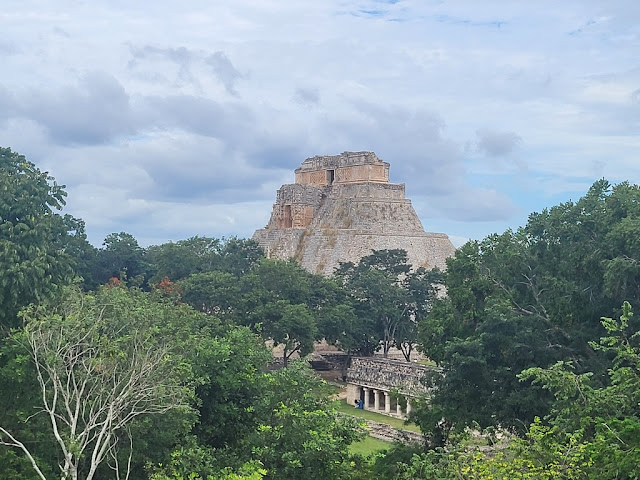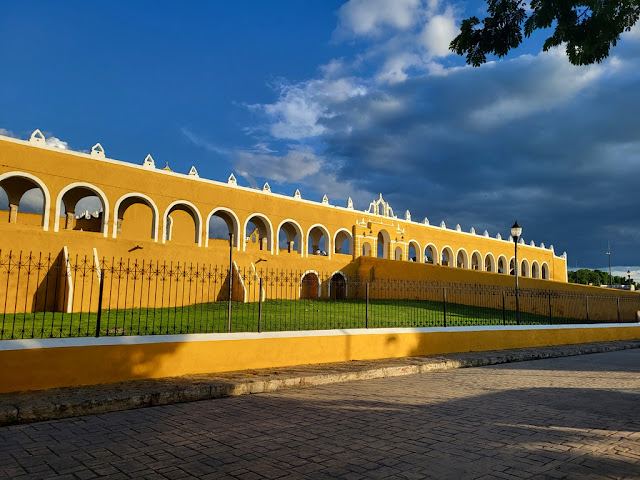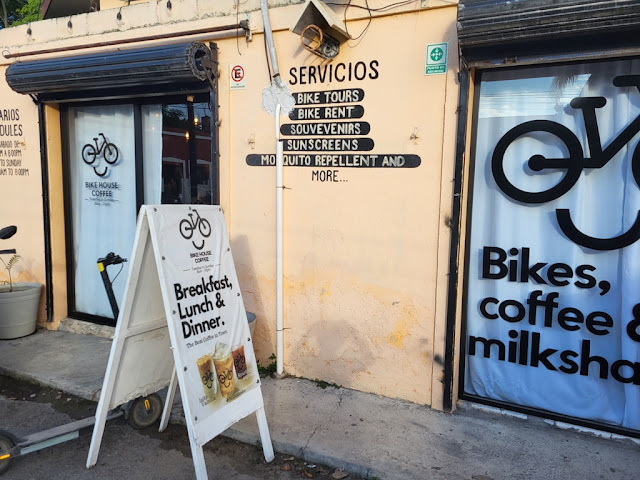Wednesday morning, 7 am
It's early enough that the metal chair
feels almost cool against my bare legs out here on the terrace, but
no, it doesn't really cool off a whole lot during the night. We are
still in the low twenties, and days go easily up to the high twenties
and low thirties. I haven't had to wear anything but sleeveless
shirts since we arrived, and I can't see that changing any time soon.
We've been here at the 'Posada El
Jardin' since Monday evening when we arrived after an uneventful bus
ride in the dark already. The 'Oriente' bus leaving from Izamal took
us all the way to the 'Centro Historico' bus terminal in Mérida
as we had been promised when we bought the tickets the day
before; this was important because it's a different bus company
('Mayab') from Mérida
to Ticul. Often the companies have their own terminals which are not
necessarily close together. The only small glitch on Monday's travel
was the fact that we missed the earlier bus to Ticul because the
first one was too late. This one left at four instead of three which
meant we arrived after sunset.
It's
always nicer to arrive in the day, of course, just because things
look different then and you get an impression of your surroundings
and sometimes it's easier to orientate yourself, but otherwise it
doesn't pose a problem: it doesn't feel unsafe here at all. We had
made sure this time that we knew where we were going, Johann took a
screenshot of the map, and I wrote down instructions of how to get to
El Jardin – still, of course we could have got mixed up like the
first day. We didn't, however, and even though there was no sign to
indicate that we had reached our destination – only a few blocks
from the bus terminal – we found it without a problem. Theresa, our
host, stood by the open gate, and I still don't know if this was just
by chance because we hadn't been able to give an exact arrival time,
nor did she know where we came from.

El
Jardin is named appropriately: it's a small tropical paradise with
trees, lush green, well tended plants, different sitting areas, a
pool and very spacious rooms, all decorated simply but tastefully.
Right in front of our room is a huge tree whose intertwined air roots
reach higher than me. Asked about its name Theresa told me that they
call it 'Alamo'.
That
first evening we only went for a walk for a few blocks to stretch our
legs a bit and get a few things from the supermarket. Ticul is a
mid-sized town of about 26,000 with nothing special that would draw
tourists, except that it's on the route to Uxmal and several other
Maya sites. There are four other guests at our little hotel, and they
are the only light-skinned people we've seen here so far. Of course
nobody speaks English, beyond here and there a couple of words,
usually less than my very lacking Spanish. Still, somehow we have
managed so far to get where and what we wanted.
Interesting juxtaposition of cultures
We
walked to the centre of town in the morning, looked at the huge
church (San Antonio de Padua), watched Christmas lights being put up
by the town and some private businesses, eventually found a bank that
a) would give us money, period, and b) without exorbitant exchange
fees, and tried to figure out how to go on from here. We found out
that a 'collectivo' – small van – goes to Santa Elena and another
one from there to the Maya site of Uxmal, both taking about twenty
minutes, and decided to take the one to Santa Elena to check out the
little town and get a feel for this venture.
The
collectivo waited until it had assembled a full load – 15
passengers plus a baby and a young kid – before it left for Santa
Elena, which makes the departure times a bit vague, of course. It
took a good half hour until this point was reached, but we were in no
hurry: we had no intention of going to Uxmal yet.
Santa
Elena is a sleepy little town (maybe appeared especially so
since it was early afternoon, siesta time?), and hardly anybody was
around. We remembered driving by a sign for a hotel/restaurant called
'The Pickled Onion' when we entered town and walked back there: the
name suggested that here somebody might speak English and give us
some information about Uxmal. The sign told us that 'The Pickled
Onion' was a kilometre in the other direction, the one we had just
come from, on the highway to Campeche City, the capital of the
province of the same name. Back we walked – there didn't seem to be
much else to do – and eventually found the hotel at the outskirts
of town. No luck with English there either, but we did find out that
the bus of the 'Sur' company stops there on its way to Campeche and
Xpujil, one of them possibly our next destination.
The
only 'attraction' in Santa Elena is the 'Museum of the Dead' that
displays the mummies of four children from the 19th
century, but we found it closed, possibly because it was still siesta
time. The collectivo back to Ticul was nowhere to be seen either, so
we found a small restaurant open with view of the taxi stand and
quenched our thirst with a beer. It takes only minutes of walking in
this heat and high humidity until one is drenched in sweat.It
takes only minutes of walking in this heat and high humidity until
one is drenched in sweat. With not too much delay the collectivo
appeared eventually, and, windows open for 'air conditioning', I
enjoyed the drive on the narrow road that allowed glimpses of small
corn fields from time to time. Traffic here is sparse, which is nice.
Not
in town, however! We had a pizza at 'La Gondola' for a late supper,
doors open to the street on two sides, and I once again marvelled at
the stream of mopeds, riven by men and women alike,
transporting families even with
small babies, the parents always wearing helmets, older children
mostly, but smaller children almost never. Once I saw a girl of maybe
five standing up on the seat between her parents, looking around. Of
course there are tuk-tuks, motorbike taxis, even 'taxis' propelled by
pedalling power, but also new and fancy cars, by far not only the old
beaters we've seen elsewhere sometimes.
On the way back to the hotel we stopped at the plaza near the church to watch the (small) school marching band practice. We had heard them the night before and now were able to watch their drill. The drums knew their part well already, but the same could not be said of the trumpets. There was a certain resemblance with a herd of elephants ... On the other side of the plaza a group of young teenage girls in school uniforms were practicing a dance routine with Christmas music, English as well as Spanish. They'll be ready for their Christmas concert, I'd say; already they were looking quite good.


























